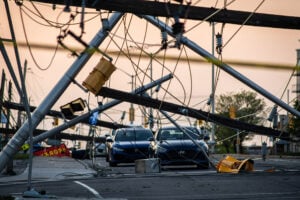
People & Culture
On thin ice: Who “owns” the Arctic?
As the climate heats up, so do talks over land ownership in the Arctic. What does Canadian Arctic Sovereignty look like as the ice melts?
- 4353 words
- 18 minutes
Environment
The conventional thinking around building design in the Arctic is changing to reflect the region’s geographic and cultural diversity and give northerners more agency

The Arctic landscape is vast and varied, so it would make sense for the region’s architecture to reflect its geographical and cultural diversity. Yet until recently, that hasn’t been the case. To better represent the range of community needs and lifestyle factors of those in the North, more designers and builders are honing in on how Arctic architecture can be made truly sustainable while also withstanding the climatic extremes of the North.
“Sustainability in the North has to have a strong cultural component,” says William Semple, an architect for NORDEC Consulting and Design who has been working on building science, design work and community engagement in the region for almost 20 years. “You have to put as much focus on cultural sustainability as environmental sustainability.”
On Oct. 25, Semple moderated and presented at a symposium on sustainable Arctic architecture hosted by the Danish Embassy. Held at Canada’s Centre for Geography and Education at 50 Sussex Drive in Ottawa, the symposium brought together top researchers in the field who are examining issues related to energy consumption and decolonizing architecture. With a focus on current conditions, while also taking into consideration the changing climate, presenters discussed several ways in which architecture can and is being improved to enhance the lives of those in the North.
A topic that received much discussion was the issue of replicating southern building traditions in the North, an approach that does not take into consideration the physical and social needs of those living in colder climates. “All of the models of housing have been based on the south, and none of them are appropriate in a whole number of ways,” says Semple. Even basic considerations such as the materials used, the level of insulation, and the quality of windows and doors are inadequate for the more extreme northern weather.
Another way in which conventional Arctic architecture has fallen short is in failing to recognize that the majority of people who live in the region are Indigenous and have different requirements for spaces that can accommodate their cultural practices and lifestyles.
“The houses we have designed have not enhanced relationships with families, nor have they done anything to connect the extended family,” says Semple, adding it’s important to listen to the community when coming up with designs. For example, in the Inuit community of Arviat, Nun., women raised concerns about a lack of storage space for items like animal skins and no room for communal gatherings in existing buildings. To resolve this issue, Semple adjusted a building design to include a sewing room that could be kept at a cooler temperature for the storage of skins and used an open-concept floor plan with an emphasis on common spaces.
Panelist Aaron Cooke, an architect by training who has lived most of his life in the North, identified five factors that can improve design in the North: culture, foundation, envelope, logistics, and change.
“There are many Norths and that should be reflected in our architecture,” he said during the symposium. Expanding on Semple’s point about the need for a culturally sensitive floor plan, Cooke explained that cultural values can find their way into floor plans in subtle ways that take a certain understanding of those who you are building for. This understanding goes beyond the home dweller and must also take into consideration where the home is being built.
In northern Alaska, for example, 40 per cent of overall construction costs come from the transportation of materials. Therefore materials should be selected based on how they transport and where they are sourced from. In Alaska, a more sustainable solution for winter heating might look like adding wood logs to the outside of homes for insulation rather than burning fuel oil.
Ultimately, says Semple, listening to the people of a community leads to a more culturally appropriate, durable, and energy-efficient project. As building science in the Arctic continues to evolve, Semple adds, the ideal scenario would be to have the architects, engineers, and designers behind projects actually based in the North. “That way it’s being done by northerners, for northerners and there are more Indigenous architects and engineers. That would be part of delivering a good long-term solution.”
Are you passionate about Canadian geography?
You can support Canadian Geographic in 3 ways:

People & Culture
As the climate heats up, so do talks over land ownership in the Arctic. What does Canadian Arctic Sovereignty look like as the ice melts?

Environment
The uncertainty and change that's currently disrupting the region dominated the annual meeting's agenda

Environment
David Boyd, a Canadian environmental lawyer and UN Special Rapporteur on Human Rights and the Environment, reveals how recognizing the human right to a healthy environment can spur positive action for the planet

Environment
Tracking the country’s extreme weather events to answer the question: are storms getting worse?